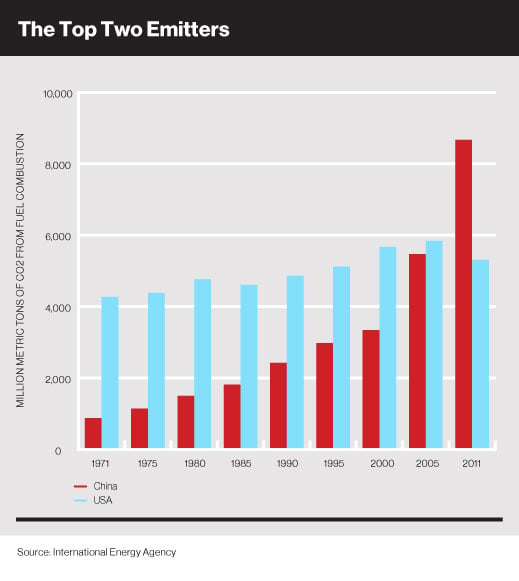China Could Deliver on Its Carbon Promise Earlier than Expected
In an agreement announced last week, China and the United States, which together account for some 45 percent of the globe’s total carbon dioxide emissions, pledged to make significant efforts in the next 10 to 15 years to limit their CO2 emissions.
It’s the first time China has publicly committed to halting the decades-long rise of its CO2 emissions. However, due to economic factors and policy shifts, China may be poised to achieve this goal even earlier than promised.
The U.S. pledged that by 2025 the amount of CO2 it emits annually would drop to 26 to 28 percent below its emission levels from 2005. China meanwhile promised that its annual CO2 emissions, which have increased by 257 percent since 1990, would stop rising by 2030 or earlier. China also pledged that 20 percent of its energy would come from sources other than fossil-fuels by 2030. That’s up from around 8 percent in 2010.

As recently as 2010, when China’s economy was still growing at more than 10 percent a year, it was unclear when its emissions might peak, says Valerie Karplus, a professor of global economics at MIT’s Sloan School of Management, and director of the Tsinghua-MIT China Energy and Climate Project.
But economic growth has slowed (it was 7.7 percent in 2012), and in turn so has growth in demand for energy.
Also, this year China’s government has already announced a plan to reduce air pollution by taxing and limiting coal use. Beyond that, carbon trading systems are now being tested in five cities and two provinces, and a national system is expected to come online in 2016.
In a recent modeling study that accounted for these new policies and assumed that China would accomplish ambitious near-term goals for expanding nuclear power and renewables, Karplus and collaborators at Tsinghua University in Beijing found that demand for coal could peak sometime between 2020 and 2025, and carbon emissions could level off sometime between 2025 and 2030.
But, says Karplus, there is still uncertainty over when China will begin actually reduce its emissions, and by how much. “It makes a big difference whether it peaks at 10 billion, 11 billion, or 15 billion metric tons of CO2,” and whether or not the trajectory decreases rapidly after that peak, says Karplus.
The pact is “hugely important” for global climate change policy efforts because China has finally agreed to a target related to “turning its emissions down in absolute value,” instead of just limiting the rate at which those emissions grow from year to year, says Michael Oppenheimer, a professor of geosciences and international affairs at Princeton University. The deal also has symbolic value, he says, since the world’s top two emitters have effectively circumvented the reigning geopolitical gridlock over international climate policy.
Keep Reading
Most Popular
Large language models can do jaw-dropping things. But nobody knows exactly why.
And that's a problem. Figuring it out is one of the biggest scientific puzzles of our time and a crucial step towards controlling more powerful future models.
The problem with plug-in hybrids? Their drivers.
Plug-in hybrids are often sold as a transition to EVs, but new data from Europe shows we’re still underestimating the emissions they produce.
How scientists traced a mysterious covid case back to six toilets
When wastewater surveillance turns into a hunt for a single infected individual, the ethics get tricky.
Google DeepMind’s new generative model makes Super Mario–like games from scratch
Genie learns how to control games by watching hours and hours of video. It could help train next-gen robots too.
Stay connected
Get the latest updates from
MIT Technology Review
Discover special offers, top stories, upcoming events, and more.